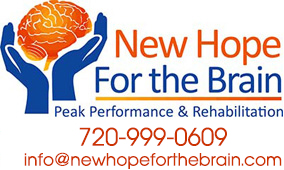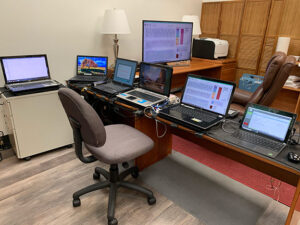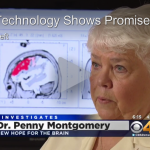LOW ENERGY NEUROFEEDBACK SYSTEM (LENS)
A healthy brain will function at a specific range of amplitude or energy (measured in microvolts) and a specific range of frequencies (measured in Hz or cycles per second). When the brain loses function which causes symptoms, it also loses energy and its frequency range is slower than normal. In this state, the brain is simply unable to carry out normal function.
The LENS neurofeedback system is designed to specifically address these issues. Sensors are placed on the scalp over 21 specific brain sites and the electrical activity of the brain (brain waves) is measured. A “profile” is created showing the dominant frequency and amplitude at each of the 21 sites. This procedure is repeated until the values at each of the sites are within normal limits.
When the LENS profile shows normal frequency and amplitude at all of the 21 sites, the brain is able to function better and symptoms are reduced. The brain is now ready to move on to the next step of our three-step protocol. This is where the brain is taught to normalize the shape of its brainwaves.
NON-LINEAR BIOFEEDBACK SYSTEM
This unique biofeedback technology provides a full body scan that explores the health of your body at the cellular level. It identifies stress in the bodily systems and organs that is interfering with the body’s ability to function at a healthy level. 3D images of how the stress is affecting various organs and systems are projected onto a computer screen. This tells whether the stress is due to toxins, bacteria, virus or other factors.
An unusual feature of this biofeedback system is that it has a built-in corrective function which emits frequencies that aid in the reduction of the stress. The rehabilitation feature of this system is its capacity to correct aberrant frequencies found in stressed or diseased tissues. This function reduces the harmful effects of stress and brings the activity of these organs and tissues to a more normal level.
We use this scan to find and minimize interference in the body’s natural healing process.
NEXUS NEUROFEEDBACK SYSTEM
The Nexus Neurofeedback system is used to “normalize” brainwaves (the 2nd step in our 3 step neurofeedback protocol). It provides the brain with information it needs to both improve the shape of the brainwave and the ratio of fast-to-slow frequency activity within specific areas of the brain. Our book, Whispers From The Brain (described elsewhere on this website), illustrates the unique morphology or shape of brainwaves in specific sites for thirty different medical conditions.
This neurofeedback over specific sites of the brain allows the brain to normalize both the shape of the brainwaves and the range of frequencies. Once this goal is achieved, the brain will function more normally.
The Nexus system was chosen because it allows the practitioner to choose the sampling rate of brainwaves greater than a thousand samples per second. Based on our experience, we believe that a sampling rate of more than a thousand samples per second is required to accurately assess the morphology. The most important information in the brainwaves appears at the top of the wave. Slower sampling rates do not display or analyze this important information.
The Nexus is also used to provide biofeedback information for muscle training, heart rate and temperature regulation.
NEUROPTIMAL TRAINING SYSTEM
The brain learns specific ways of functioning by creating habits of neuronal firing patterns. Neuronal firing patterns that are repeated become habitual. Maladaptive firing patterns that have become habitual interfere with the brain’s retention of newly acquired normal firing patterns. The normalization of brain waves is acquired in amplitude neurofeedback. Newly acquired normal firing patterns will be unstable in specific frequency bands.
The NeurOptimal training system monitors stability in each frequency band. When a “wobble” or unstable event happens, it triggers an interruption in music that the client is listening to through earphones. The interruption calls the brain’s attention to the wobble and the brain stabilizes or normalizes the activity in that specific frequency band. It should be noted that the brain knows what is needed to “fix” almost anything in the body and will only change aberrant functioning when its attention is called to the problem. When the brain’s attention has been repeatedly called to wobbles, it forms a habit of normal, stable function in that frequency band.
NEUROFIELD Z3
When the brain experiences injury or illness from viruses or bacteria, it loses energy and becomes too weak to participate in its own recovery. When the electrical activity in the brain has lost amplitude or healthy frequency distribution, it can benefit from the application of specific low voltage current. The Neurofield Z3 provides very low voltage current in specific protocols to correct amplitude and drive the brainwaves to return to healthy function.
FIREFLY FAR INFRARED
Far Infrared therapy is a technology that increases blood flow by expanding the capillaries that carry blood throughout the body. It also increases oxygenation and regeneration of the blood, detoxifying it for improved functioning of all the major organs in the body which depend on blood for life and energy.
The brain requires a steady flow of oxygen and nutrients to function optimally. This lifeline to the brain comes in the form of blood flow. The intricate network of blood vessels plays a crucial role in delivering oxygen and nutrients to the brain. The cerebrovascular system consists of arteries, arterioles, capillaries and veins that work in harmony to ensure sufficient blood supply to the brain.
Blood flow to the brain becomes impaired where there is an accumulation of plaque or clotting. Cerebrovascular diseases such as ischemic strokes occur when blood flow to the brain is compromised due to these blockages or narrowing of the arteries. Such conditions lead to serious consequences.
The Firefly technology delivers far infrared energy that is adequate to open blood flow in clogged arteries in just a few seconds.
HEARTMATH TECHNOLOGY
HeartMath is a heavily researched technology that uses biofeedback devices to regulate emotions and reduce stress. It uses the interactions between the heart and the brain and measures how neurophysiological patterns of heart activity affect the brain’s functioning. Measurement of the beat-to-beat changes in heart rate is known as heart rate variability or HRV.
The ability to synchronize activity between the heart and brain using the combined measurements of heart rate variability, blood pressure and respiration has been shown to lead to a state of psychophysiological coherence otherwise known as optimal functioning.
There is growing acceptance within the broad medical community that HRV amplitude is a key indicator of health status. Adequate amplitude is indicative of sound health and inadequate amplitude indicative of health risk. HRV coherence has emerged as a key indicator of balance in the autonomic nervous system.
CAPNO TRAINER
Overbreathing, also known as hyperventilation, can be described as a condition where an individual breathes at a faster or deeper rate than necessary for the body’s metabolic needs. This leads to a decrease in the concentration of carbon dioxide (CO2) in the blood and an increase in the concentration of oxygen (O2).
Normally, our respiratory system works to maintain a balance between oxygen and carbon dioxide levels in the body that are regulated by the brain and various chemical receptors. However, in cases of overbreathing, this balance is disrupted.
Overbreathing has several physiological effects. First, it leads to a decrease in carbon dioxide levels, which causes the blood vessels to constrict (vasoconstriction). This can lead to symptoms such as dizziness, lightheadedness, or tingling sensations in the extremities. Additionally, low carbon dioxide levels can cause a shift in the pH balance of the blood, making it more alkaline called respiratory alkalosis.
These changes can affect the normal functioning of the body, including reduced oxygen delivery to tissues, increased excitability of nerves and muscles as well as alterations in the functioning of certain organs, such as the heart. These effects can cause symptoms such as rapid heartbeat, shortness of breath, chest pain, numbness or tingling in the fingers and around the mouth, and feelings of breathlessness.
Capnometry biofeedback is a method used to measure the concentration of carbon dioxide (CO2) in the respiratory system. It involves the use of a technology called a capno trainer. The capno trainer measures the level of carbon dioxide left in the lungs at the end of exhalation to determine whether there is sufficient CO2 to mix well with O2 in the next breath. Training on this device will teach proper breathing and eliminate the effects of overbreathing.
QUANTUM RESONANCE MAGNETIC ANALYZER
The Quantum Resonance Magnetic Analyzer is a scientific device that uses the principles of quantum mechanics and magnetic resonance to analyze various aspects of a person’s health and well-being. It operates on the concept of quantum resonance, which refers to the interaction between the electromagnetic signals of the human body and the analyzer’s magnetic field.
The technology consists of a handheld scanner that is connected to a computer. The scanner emits low-intensity electromagnetic waves which scan the body and interacts with tissues, organs and cells. These interactions result in the emission of weak electromagnetic signals from the body which are then picked up by the scanner.
The scanner detects and records these signals and the information is processed and analyzed by the attached computer. The analysis includes evaluating the body’s energy levels, physiological processes, the presence of toxins or pathogens and the overall balance and functioning of different systems within the body.
Based on the collected data, the Quantum Resonance Magnetic Analyzer generates a comprehensive report which provides insights into a person’s current health status, potential health risks and recommendations for improving well-being. This device provides a non-invasive and holistic approach to health assessment and supports personalized wellness management.


